Report: Human Factors Analysis of American Airlines Flight 1420 Crash
VerifiedAdded on 2022/09/23
|6
|1341
|23
Report
AI Summary
This report provides a comprehensive analysis of the American Airlines Flight 1420 crash, which occurred during landing at Little Rock National Airport. It utilizes the Human Factor Classification System (HFACS) to identify and discuss the human factors contributing to the accident. These factors include the crew's decision to proceed with the flight despite hazardous weather conditions, their failure to extend spoilers, and impaired performance due to fatigue and stress. The report examines the error chain, highlighting crew errors such as failing to complete the pre-landing checklist, not arming the spoiler system, and not setting the automatic braking system. It also addresses the captain's use of excessive reverse thrust. The report concludes that the crash was preventable and emphasizes the importance of adherence to safety procedures and crew management to avoid similar incidents. The analysis underscores critical issues related to pilot decision-making, fatigue, and weather-related risks, offering recommendations for improved aviation safety practices.
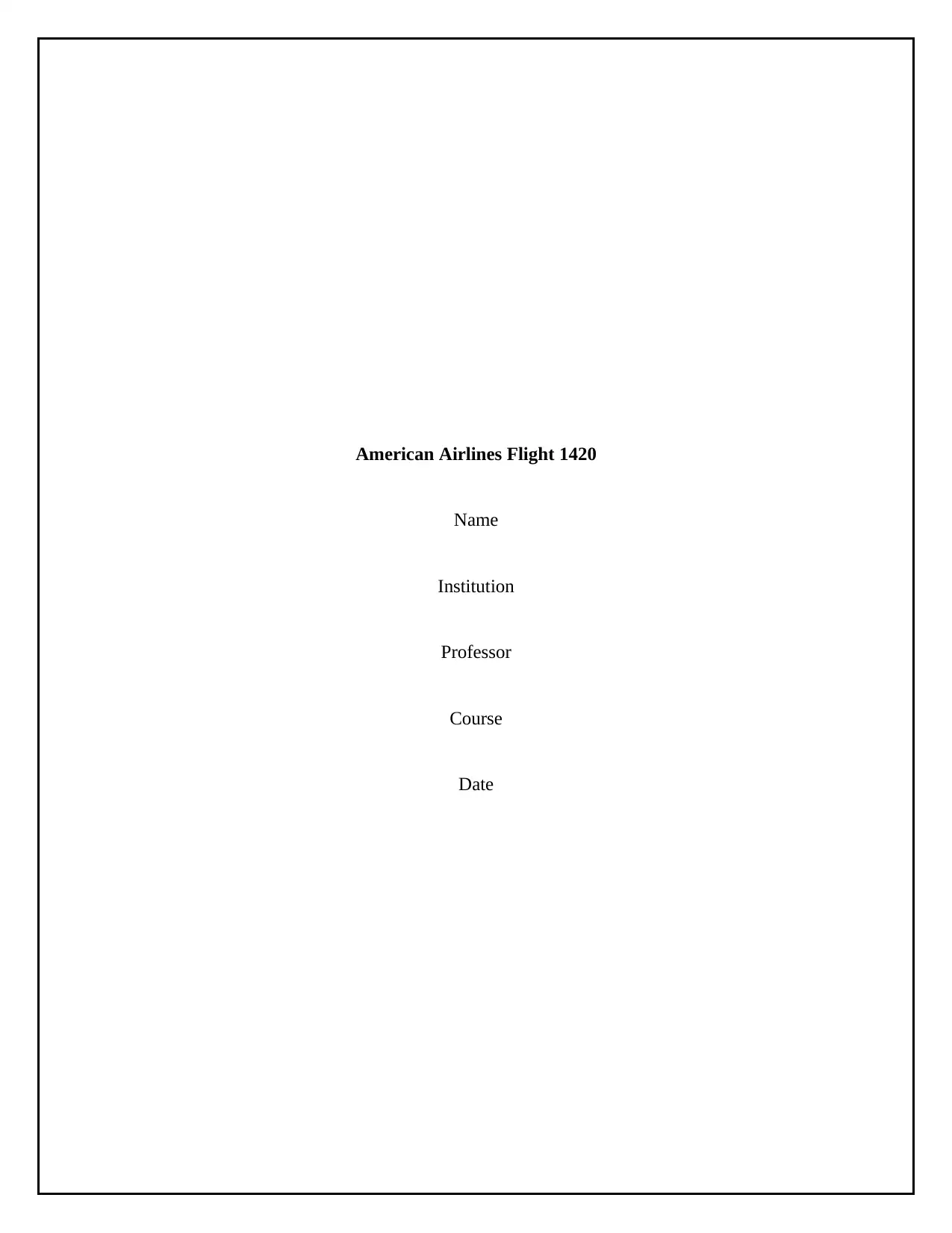
American Airlines Flight 1420
Name
Institution
Professor
Course
Date
Name
Institution
Professor
Course
Date
Paraphrase This Document
Need a fresh take? Get an instant paraphrase of this document with our AI Paraphraser
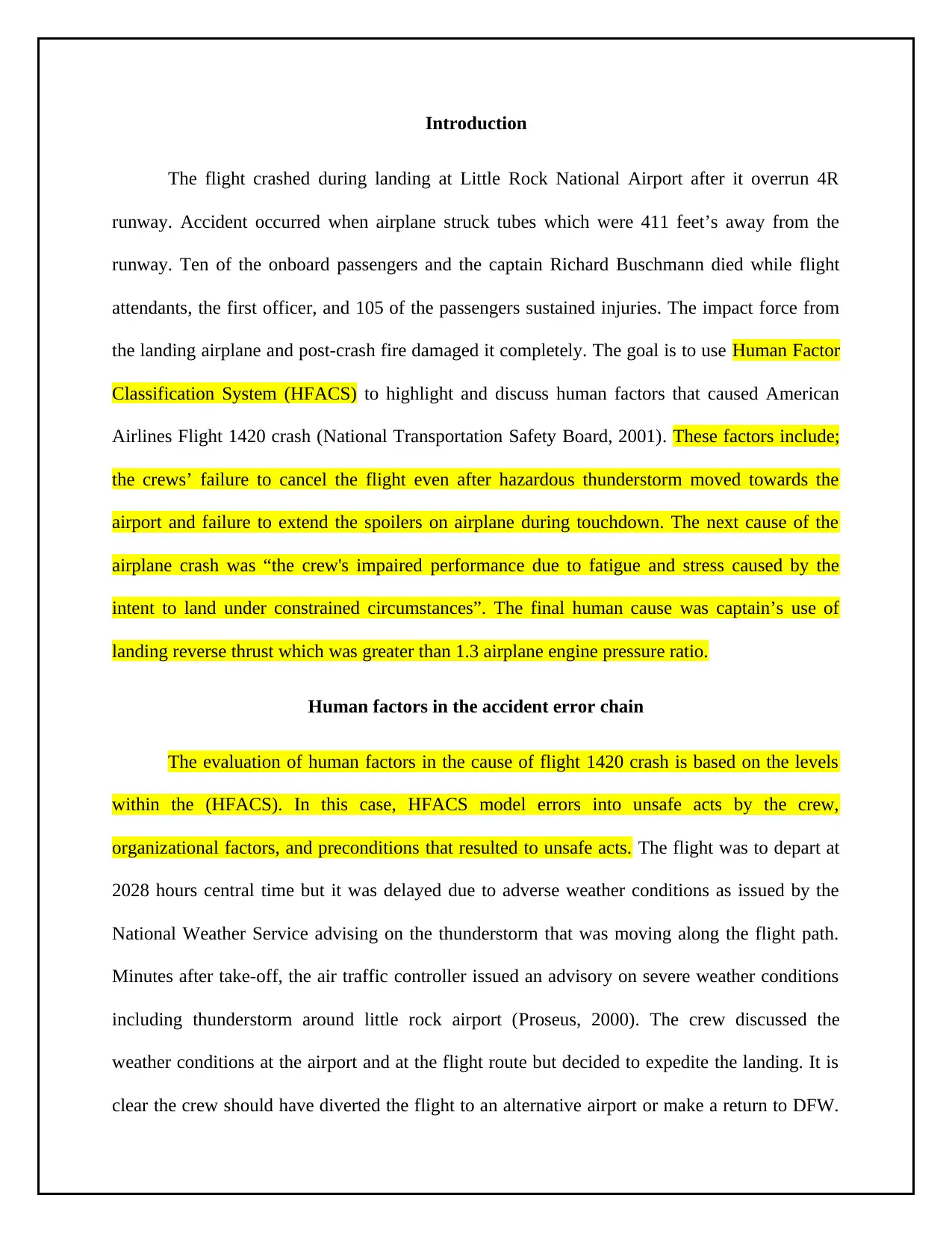
Introduction
The flight crashed during landing at Little Rock National Airport after it overrun 4R
runway. Accident occurred when airplane struck tubes which were 411 feet’s away from the
runway. Ten of the onboard passengers and the captain Richard Buschmann died while flight
attendants, the first officer, and 105 of the passengers sustained injuries. The impact force from
the landing airplane and post-crash fire damaged it completely. The goal is to use Human Factor
Classification System (HFACS) to highlight and discuss human factors that caused American
Airlines Flight 1420 crash (National Transportation Safety Board, 2001). These factors include;
the crews’ failure to cancel the flight even after hazardous thunderstorm moved towards the
airport and failure to extend the spoilers on airplane during touchdown. The next cause of the
airplane crash was “the crew's impaired performance due to fatigue and stress caused by the
intent to land under constrained circumstances”. The final human cause was captain’s use of
landing reverse thrust which was greater than 1.3 airplane engine pressure ratio.
Human factors in the accident error chain
The evaluation of human factors in the cause of flight 1420 crash is based on the levels
within the (HFACS). In this case, HFACS model errors into unsafe acts by the crew,
organizational factors, and preconditions that resulted to unsafe acts. The flight was to depart at
2028 hours central time but it was delayed due to adverse weather conditions as issued by the
National Weather Service advising on the thunderstorm that was moving along the flight path.
Minutes after take-off, the air traffic controller issued an advisory on severe weather conditions
including thunderstorm around little rock airport (Proseus, 2000). The crew discussed the
weather conditions at the airport and at the flight route but decided to expedite the landing. It is
clear the crew should have diverted the flight to an alternative airport or make a return to DFW.
The flight crashed during landing at Little Rock National Airport after it overrun 4R
runway. Accident occurred when airplane struck tubes which were 411 feet’s away from the
runway. Ten of the onboard passengers and the captain Richard Buschmann died while flight
attendants, the first officer, and 105 of the passengers sustained injuries. The impact force from
the landing airplane and post-crash fire damaged it completely. The goal is to use Human Factor
Classification System (HFACS) to highlight and discuss human factors that caused American
Airlines Flight 1420 crash (National Transportation Safety Board, 2001). These factors include;
the crews’ failure to cancel the flight even after hazardous thunderstorm moved towards the
airport and failure to extend the spoilers on airplane during touchdown. The next cause of the
airplane crash was “the crew's impaired performance due to fatigue and stress caused by the
intent to land under constrained circumstances”. The final human cause was captain’s use of
landing reverse thrust which was greater than 1.3 airplane engine pressure ratio.
Human factors in the accident error chain
The evaluation of human factors in the cause of flight 1420 crash is based on the levels
within the (HFACS). In this case, HFACS model errors into unsafe acts by the crew,
organizational factors, and preconditions that resulted to unsafe acts. The flight was to depart at
2028 hours central time but it was delayed due to adverse weather conditions as issued by the
National Weather Service advising on the thunderstorm that was moving along the flight path.
Minutes after take-off, the air traffic controller issued an advisory on severe weather conditions
including thunderstorm around little rock airport (Proseus, 2000). The crew discussed the
weather conditions at the airport and at the flight route but decided to expedite the landing. It is
clear the crew should have diverted the flight to an alternative airport or make a return to DFW.
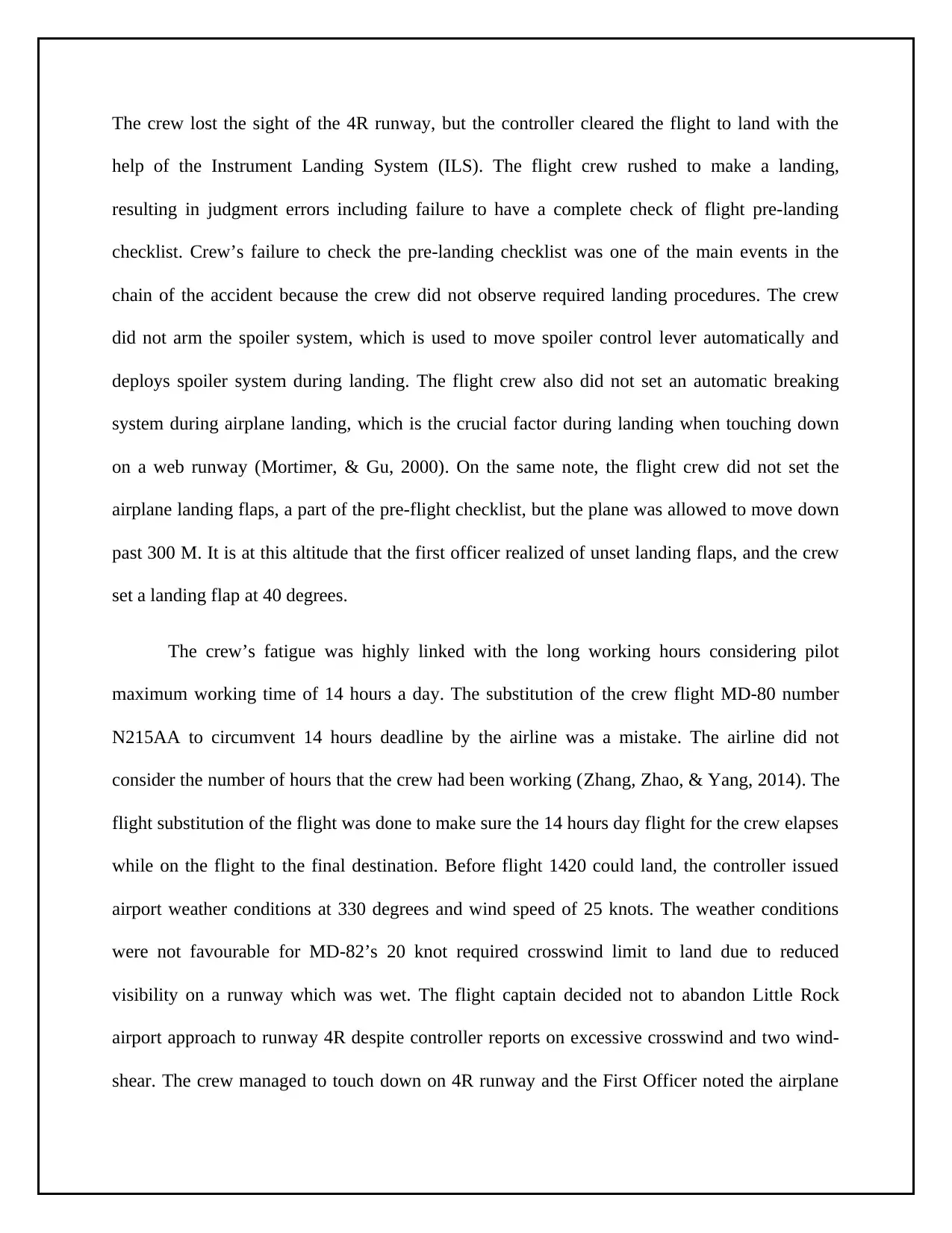
The crew lost the sight of the 4R runway, but the controller cleared the flight to land with the
help of the Instrument Landing System (ILS). The flight crew rushed to make a landing,
resulting in judgment errors including failure to have a complete check of flight pre-landing
checklist. Crew’s failure to check the pre-landing checklist was one of the main events in the
chain of the accident because the crew did not observe required landing procedures. The crew
did not arm the spoiler system, which is used to move spoiler control lever automatically and
deploys spoiler system during landing. The flight crew also did not set an automatic breaking
system during airplane landing, which is the crucial factor during landing when touching down
on a web runway (Mortimer, & Gu, 2000). On the same note, the flight crew did not set the
airplane landing flaps, a part of the pre-flight checklist, but the plane was allowed to move down
past 300 M. It is at this altitude that the first officer realized of unset landing flaps, and the crew
set a landing flap at 40 degrees.
The crew’s fatigue was highly linked with the long working hours considering pilot
maximum working time of 14 hours a day. The substitution of the crew flight MD-80 number
N215AA to circumvent 14 hours deadline by the airline was a mistake. The airline did not
consider the number of hours that the crew had been working (Zhang, Zhao, & Yang, 2014). The
flight substitution of the flight was done to make sure the 14 hours day flight for the crew elapses
while on the flight to the final destination. Before flight 1420 could land, the controller issued
airport weather conditions at 330 degrees and wind speed of 25 knots. The weather conditions
were not favourable for MD-82’s 20 knot required crosswind limit to land due to reduced
visibility on a runway which was wet. The flight captain decided not to abandon Little Rock
airport approach to runway 4R despite controller reports on excessive crosswind and two wind-
shear. The crew managed to touch down on 4R runway and the First Officer noted the airplane
help of the Instrument Landing System (ILS). The flight crew rushed to make a landing,
resulting in judgment errors including failure to have a complete check of flight pre-landing
checklist. Crew’s failure to check the pre-landing checklist was one of the main events in the
chain of the accident because the crew did not observe required landing procedures. The crew
did not arm the spoiler system, which is used to move spoiler control lever automatically and
deploys spoiler system during landing. The flight crew also did not set an automatic breaking
system during airplane landing, which is the crucial factor during landing when touching down
on a web runway (Mortimer, & Gu, 2000). On the same note, the flight crew did not set the
airplane landing flaps, a part of the pre-flight checklist, but the plane was allowed to move down
past 300 M. It is at this altitude that the first officer realized of unset landing flaps, and the crew
set a landing flap at 40 degrees.
The crew’s fatigue was highly linked with the long working hours considering pilot
maximum working time of 14 hours a day. The substitution of the crew flight MD-80 number
N215AA to circumvent 14 hours deadline by the airline was a mistake. The airline did not
consider the number of hours that the crew had been working (Zhang, Zhao, & Yang, 2014). The
flight substitution of the flight was done to make sure the 14 hours day flight for the crew elapses
while on the flight to the final destination. Before flight 1420 could land, the controller issued
airport weather conditions at 330 degrees and wind speed of 25 knots. The weather conditions
were not favourable for MD-82’s 20 knot required crosswind limit to land due to reduced
visibility on a runway which was wet. The flight captain decided not to abandon Little Rock
airport approach to runway 4R despite controller reports on excessive crosswind and two wind-
shear. The crew managed to touch down on 4R runway and the First Officer noted the airplane
⊘ This is a preview!⊘
Do you want full access?
Subscribe today to unlock all pages.

Trusted by 1+ million students worldwide
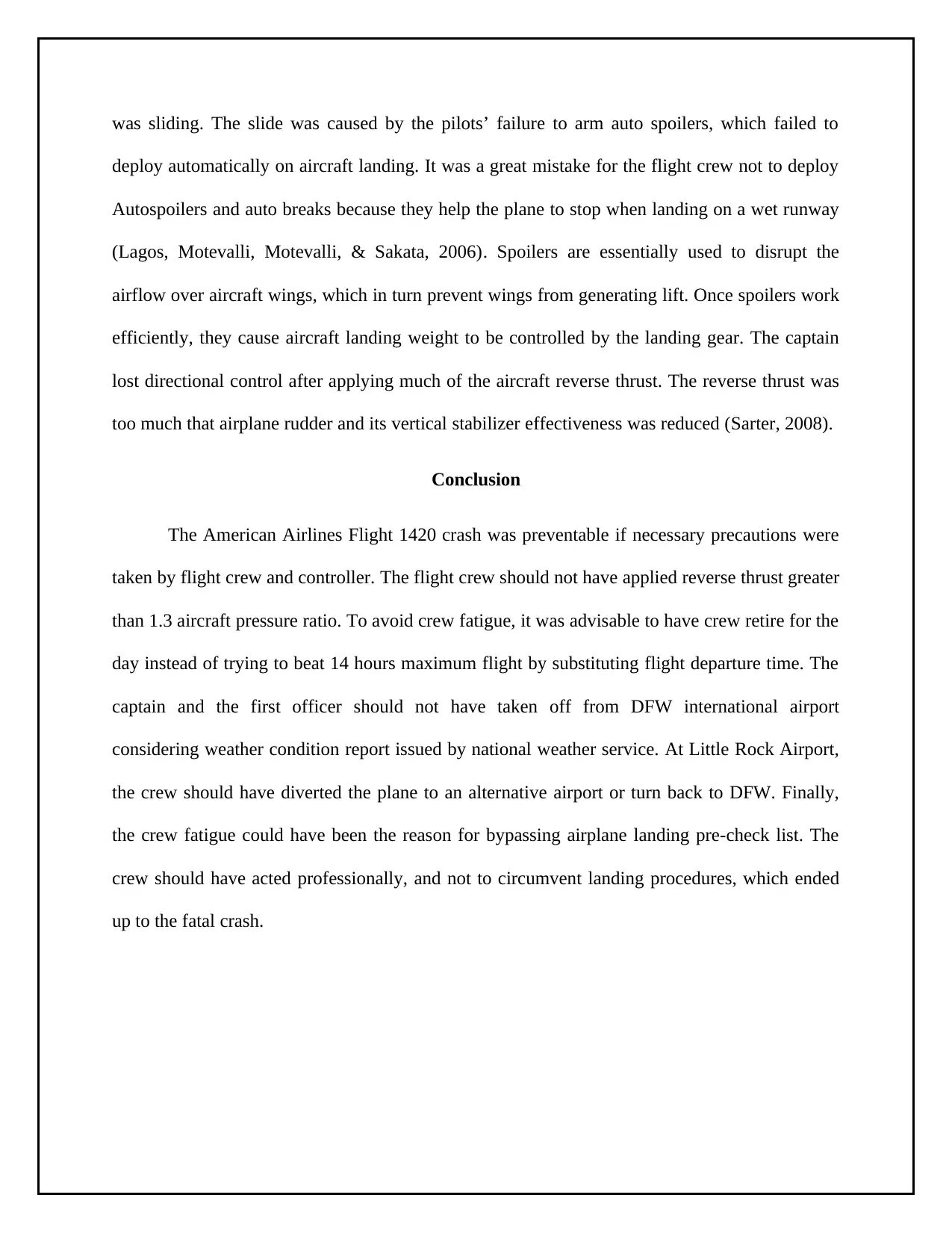
was sliding. The slide was caused by the pilots’ failure to arm auto spoilers, which failed to
deploy automatically on aircraft landing. It was a great mistake for the flight crew not to deploy
Autospoilers and auto breaks because they help the plane to stop when landing on a wet runway
(Lagos, Motevalli, Motevalli, & Sakata, 2006). Spoilers are essentially used to disrupt the
airflow over aircraft wings, which in turn prevent wings from generating lift. Once spoilers work
efficiently, they cause aircraft landing weight to be controlled by the landing gear. The captain
lost directional control after applying much of the aircraft reverse thrust. The reverse thrust was
too much that airplane rudder and its vertical stabilizer effectiveness was reduced (Sarter, 2008).
Conclusion
The American Airlines Flight 1420 crash was preventable if necessary precautions were
taken by flight crew and controller. The flight crew should not have applied reverse thrust greater
than 1.3 aircraft pressure ratio. To avoid crew fatigue, it was advisable to have crew retire for the
day instead of trying to beat 14 hours maximum flight by substituting flight departure time. The
captain and the first officer should not have taken off from DFW international airport
considering weather condition report issued by national weather service. At Little Rock Airport,
the crew should have diverted the plane to an alternative airport or turn back to DFW. Finally,
the crew fatigue could have been the reason for bypassing airplane landing pre-check list. The
crew should have acted professionally, and not to circumvent landing procedures, which ended
up to the fatal crash.
deploy automatically on aircraft landing. It was a great mistake for the flight crew not to deploy
Autospoilers and auto breaks because they help the plane to stop when landing on a wet runway
(Lagos, Motevalli, Motevalli, & Sakata, 2006). Spoilers are essentially used to disrupt the
airflow over aircraft wings, which in turn prevent wings from generating lift. Once spoilers work
efficiently, they cause aircraft landing weight to be controlled by the landing gear. The captain
lost directional control after applying much of the aircraft reverse thrust. The reverse thrust was
too much that airplane rudder and its vertical stabilizer effectiveness was reduced (Sarter, 2008).
Conclusion
The American Airlines Flight 1420 crash was preventable if necessary precautions were
taken by flight crew and controller. The flight crew should not have applied reverse thrust greater
than 1.3 aircraft pressure ratio. To avoid crew fatigue, it was advisable to have crew retire for the
day instead of trying to beat 14 hours maximum flight by substituting flight departure time. The
captain and the first officer should not have taken off from DFW international airport
considering weather condition report issued by national weather service. At Little Rock Airport,
the crew should have diverted the plane to an alternative airport or turn back to DFW. Finally,
the crew fatigue could have been the reason for bypassing airplane landing pre-check list. The
crew should have acted professionally, and not to circumvent landing procedures, which ended
up to the fatal crash.
Paraphrase This Document
Need a fresh take? Get an instant paraphrase of this document with our AI Paraphraser
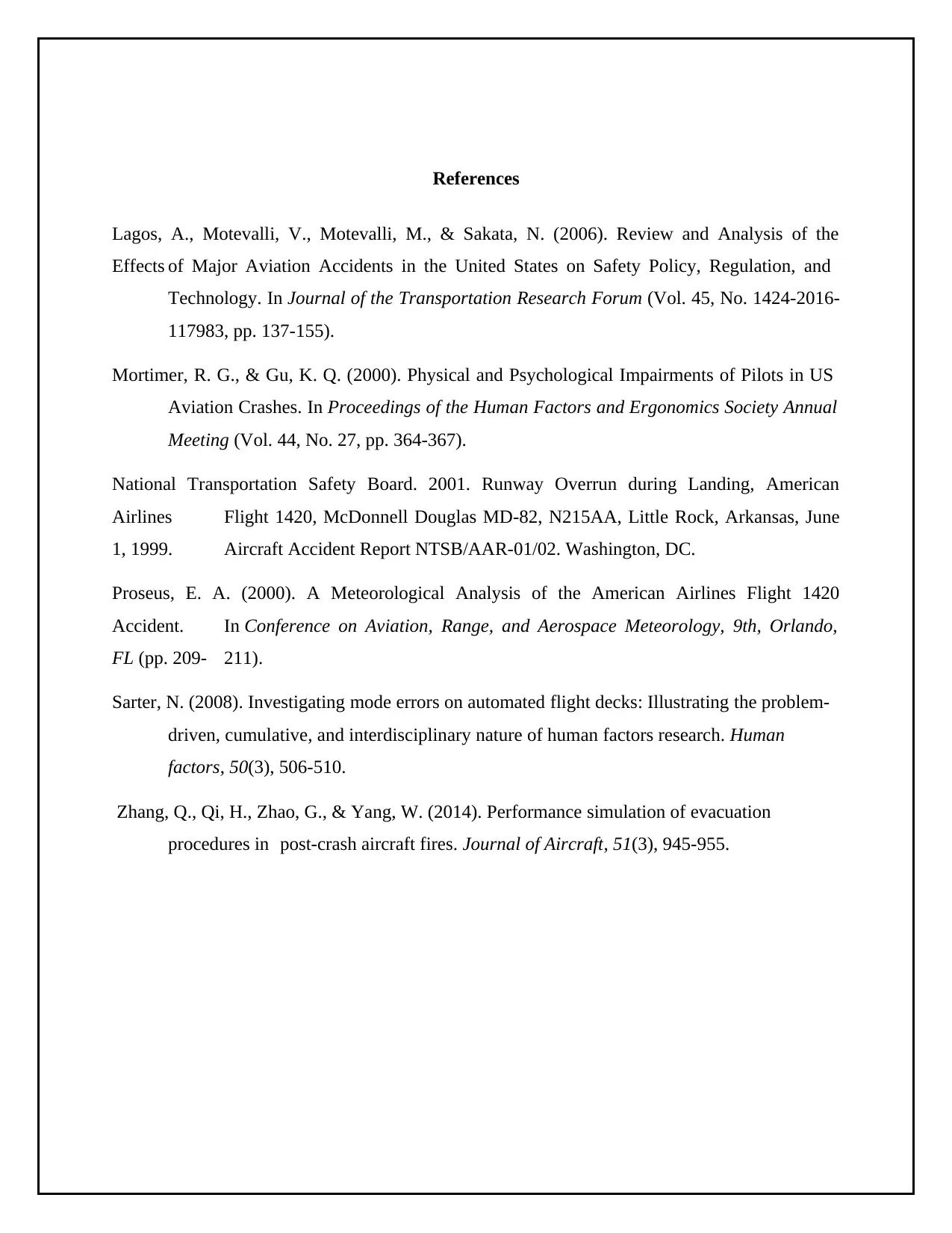
References
Lagos, A., Motevalli, V., Motevalli, M., & Sakata, N. (2006). Review and Analysis of the
Effects of Major Aviation Accidents in the United States on Safety Policy, Regulation, and
Technology. In Journal of the Transportation Research Forum (Vol. 45, No. 1424-2016-
117983, pp. 137-155).
Mortimer, R. G., & Gu, K. Q. (2000). Physical and Psychological Impairments of Pilots in US
Aviation Crashes. In Proceedings of the Human Factors and Ergonomics Society Annual
Meeting (Vol. 44, No. 27, pp. 364-367).
National Transportation Safety Board. 2001. Runway Overrun during Landing, American
Airlines Flight 1420, McDonnell Douglas MD-82, N215AA, Little Rock, Arkansas, June
1, 1999. Aircraft Accident Report NTSB/AAR-01/02. Washington, DC.
Proseus, E. A. (2000). A Meteorological Analysis of the American Airlines Flight 1420
Accident. In Conference on Aviation, Range, and Aerospace Meteorology, 9th, Orlando,
FL (pp. 209- 211).
Sarter, N. (2008). Investigating mode errors on automated flight decks: Illustrating the problem-
driven, cumulative, and interdisciplinary nature of human factors research. Human
factors, 50(3), 506-510.
Zhang, Q., Qi, H., Zhao, G., & Yang, W. (2014). Performance simulation of evacuation
procedures in post-crash aircraft fires. Journal of Aircraft, 51(3), 945-955.
Lagos, A., Motevalli, V., Motevalli, M., & Sakata, N. (2006). Review and Analysis of the
Effects of Major Aviation Accidents in the United States on Safety Policy, Regulation, and
Technology. In Journal of the Transportation Research Forum (Vol. 45, No. 1424-2016-
117983, pp. 137-155).
Mortimer, R. G., & Gu, K. Q. (2000). Physical and Psychological Impairments of Pilots in US
Aviation Crashes. In Proceedings of the Human Factors and Ergonomics Society Annual
Meeting (Vol. 44, No. 27, pp. 364-367).
National Transportation Safety Board. 2001. Runway Overrun during Landing, American
Airlines Flight 1420, McDonnell Douglas MD-82, N215AA, Little Rock, Arkansas, June
1, 1999. Aircraft Accident Report NTSB/AAR-01/02. Washington, DC.
Proseus, E. A. (2000). A Meteorological Analysis of the American Airlines Flight 1420
Accident. In Conference on Aviation, Range, and Aerospace Meteorology, 9th, Orlando,
FL (pp. 209- 211).
Sarter, N. (2008). Investigating mode errors on automated flight decks: Illustrating the problem-
driven, cumulative, and interdisciplinary nature of human factors research. Human
factors, 50(3), 506-510.
Zhang, Q., Qi, H., Zhao, G., & Yang, W. (2014). Performance simulation of evacuation
procedures in post-crash aircraft fires. Journal of Aircraft, 51(3), 945-955.

⊘ This is a preview!⊘
Do you want full access?
Subscribe today to unlock all pages.

Trusted by 1+ million students worldwide
1 out of 6
Related Documents
Your All-in-One AI-Powered Toolkit for Academic Success.
+13062052269
info@desklib.com
Available 24*7 on WhatsApp / Email
![[object Object]](/_next/static/media/star-bottom.7253800d.svg)
Unlock your academic potential
Copyright © 2020–2025 A2Z Services. All Rights Reserved. Developed and managed by ZUCOL.




